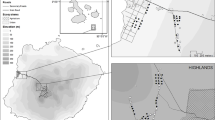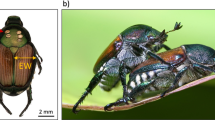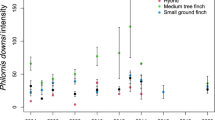Abstract
For aquatic mites parasitic on dragonflies, completion of their life cycle depends on their being returned to appropriate water bodies by their hosts, after completion of engorgement. We examined whether differences among hosts in timing of emergence or phenotypic attributes might affect their probability of return to an emergence pond, and hence success of mites. Parasitized males and females of the dragonfly Sympetrum obtrusum (Hagen) did not differ in overall recapture rates. Females that had wing cell symmetry and emerged early were more likely to be recaptured than females that emerged later or had wing cell asymmetry, but there were no consistent relations between these variables and parasitism by mites. No such relations between wing cell asymmetry, emergence date, and recapture likelihood were found for males. Using randomization tests, we found that mean intensities of Arrenurus planus (Marshall) mites at host emergence were the same for recaptured females and females not recaptured; however, males that were recaptured had lower mean intensities of mites at emergence than males not recaptured. Further, mature females carried more mites than mature males, and the latter had fewer mites than newly emerged males not recaptured. Biases in detachment of engorging mites do not explain the differences in parasitism between mature males and females, nor the differences in mite numbers between mature males and newly emerged males that were not recaptured. Rather, heavily parasitized males appear to disperse or die and are not recaptured, which should have implications for dispersal of mites and fitness of male hosts.
Similar content being viewed by others

References
Åbro A. 1979. Attachment and feeding devices of water mite larvae (Arrenurus spp. )parasitic on damsel. ies (Odonata,Zygoptera). Zool. Scripta,8:221–234.
Åbro A. 1982. The e. ects of parasitic water mite larvae (Arrenurus spp. )on zygopteran imagoes. J. Inv. Pathol. 39:373–381.
Andrés J. A. and Cordero Rivera A. 1998. Effects of water mites on the damsel. y Ceriagrion tenellum. Ecol. Entomol. 25:103–109.
Anholt B. R. 1990. Size-biased dispersal prior to breeding in a damsel. y. Oecologia 83:385–287.
Banks M. J. and Thompson D. J. 1987. Lifetime reproductive success of females of the damsel. y, Coenagrion puella. J. Anim. Ecol. 56:815–832.
Bohonak A. J. 1999. E. ect of insect-mediated dispersal on the genetic structure of postglacial water mite populations. Heredity 82:451–461.
Bonn A., Gasse M., Rol. J. and Martens A. 1996. Increased. uctuating asymmetry in the damsel. y Coenagrion puella is correlated with ectoparasitic water mites:implications for. uctuating asymmetry theory. Oecologia 108:596–598.
Braune P. and Rol. J. 2001. Parasitism and survival in a damsel. y:does host sex matter?Proc. R. Soc. Lond. B 268:1133–1137.
Carchini G., Chirotti F., Domenico M. and Paganotti G. 2000. Fluctuating asymmetry,size and mating success in males of Ischnura elegans (Vander Linden)(Odonata:Coenagrionidae). Anim. Behav. 59:177–182.
Carchini G., Chirotti F., Domenico M., Mattoccia M. and Paganotti G. 2001. Fluctuating asymmetry,mating success,body size and heterozygosity in Coenagrion scitulum (Rambur) (Odonata:Coenagrionidae). Anim. Behav. 61:661–669.
Conrad K. F., Willson K. H., Whitfield K., Harvey I. F., Tomas C. J. and Sherratt T. M. 2002. Characteristics of dispersing Ischnura elegans and Coenagrion puella (Odonata):age,sex,size, morph and ectoparasitism. Ecography 25:439–445.
Corbet P. S. 1999. Dragon. ies:Behavior and Ecology of Odonata. Cornell University Press, Ithaca, New York,pp. 829.
Cordero Rivera A. 2000. An analysis of multivariate selection in a non-territorial damsel. y (Odonata:Coenagrionidae). Etología 8:37–41.
Córdoba-Aguilar A. 1995. Fluctuating asymmetry in paired and unpaired damsel. y males,Ischnura denticollis (Burmeister)(Odonata:Coengrionidae). J. Ethol. 13:129–132.
Fincke O. M. 1982. Lifetime Mating Success in a Natural-Population of the Damsel. y,Enallagma hageni (Walsh)(Odonata,Coenagrionidae). Behav. Ecol. Sociobiol. 10:293–302.
Forbes M. R. 1991. Ectoparasites and mating success of male Enallagma ebrium damsel. ies (Odonata:Coenagrionidae). Oikos 60:336–342.
Forbes M. R. and Baker R. L. 1990. Susceptibility to parasitism:experiments with the damsel. y Enallagma ebrium (Odonata:Coenagrionidae)and larval water mites,Arrenurus spp. (Acari: Arrenuridae). Oikos 58:61–66.
Forbes M. R. L. and Baker R. L. 1991. Condition and fecundity of the damsel. y,Enallagma ebrium (Hagen):the importance of ectoparasites. Oecologia 86:335–341.
Forbes M. R. and Leung B. 1995. Pre-fabricated dining shelters as outdoor insectaries,an assessment using Enallagma ebrium (Hagen)(Zygoptera:Coenagrionidae). Odonatologica 24:461–466.
Forbes M. R., Leung B. and Schalk G. 1997. Fluctuating asymmetry in Coenagrion resolutum (Hagen)in relation to age and male pairing success (Zygoptera:Coenagrionidae). Odonatologica 26:9–16.
Forbes M. R., Muma K. E. and Smith B. P. 1999. Parasitism of Sympetrum dragon. ies by Arrenurus planus mites:maintenance of resistance particular to one species. Int. J. Parasitol. 29:991–999.
Forbes M. R., Muma K. E. and Smith B. P. 2002. Di. use coevolution:constraints on a generalist parasite favor use of a dead-end host. Ecography 25:345–351.
Hardersen S., Wratten S. D. and Frampton C. M. 1999. Does carbaryl increase. uctuating asymmetry in damsel. ies under eld conditions?A mesocosm experiment with Xanthocnemis zealandica (Odonata:Zygoptera)J. Appl. Ecol. 36:534–543.
Harvey I. F. and Walsh K. J. 1993. Fluctuating asymmetry and lifetime mating success are correlated in males of the damsel. y Coenagrion puella (Odonata:Coenagrionidae). Ecol. Ent. 18:198–202.
Lajeunesse M. J. and Forbes M. R. 2002. Host range and local parasite adaptation. Proc. R. Soc. Lond. Ser. B 269:703–710.
Leónard N. J., Forbes M. R. and Baker R. L. 1999. E. ects of Limnochares americana (Hydrachnida: Limnocharidae)mites on life history traits and grooming behaviour of its damsel. y host,Enallagma ebrium (Odonata:Coenagrionidae). Can. J. Zool. 77:1615–1622.
Leung B. and Forbes M. R. 1997. Fluctuating asymmetry in relation to indices of quality and tness in the damsel. y,Enallagma ebrium (Hagen). Oecologia 110:472–477.
Leung B., Forbes M. R. and Baker R. L. 2001. Nutritional stress and behavioural immunity of damsel. ies. Anim. Behav. 61:1093–1099.
Manly B. F. J. 1997. Randomization,Bootstrap and Monte Carlo Methods in Biology,2nd ed. Chapman & Hall, UK,399 p.
McKee D., Harvey I., Thomas M. and Sherratt T. N. 2003. Mite infestation of Xanthocnemis zealandica (McLachlan)in a Christchurch Pond. New Zeal. J. Zool. 30:17–20.
Michiels N. K. and Dhondt A. A. 1991. Characteristics of dispersal in sexually mature dragonflies. Ecol. Entomol. 16:449–459.
Mitchell R. 1968. Site selection by larval water mites parasitic on the damsel. y Cercion hieroglyphicum Brauer. Ecology 49:40–47.
Rehfeldt G. E. 1995. Natuörliche Feinde,Parasiten und Forp. anzen von Libellen. Wolfram Schmidt, Braunschweig.
Reinhardt K. 1996. Negative e. ects of Arrenurus water mites of the. ight distance of the damsel. y, Nehalennia speciosa (Odonata:Coenagrionidae). Aq. Insects 18:233–240.
Robinson J. V. 1983. E. ects of water mite parasitism on the demographics of an adult population of Ischnura posita (hagen)(Odonata:Coenagrionidae). Am. Midl. Nat. 109:169–174.
Rol. J. 1999. Parasitism increases o. spring size in a damsel. y:experimental evidence for parasite-mediated maternal e. ects. Anim. Behav. 58:1105–1108.
Rol. J., Antvogel H. and Schrimpf I. 2000. No correlation between ectoparasitism and male mating success in a damsel. y:why parasite behavior matters. J. Insect Behav. 13:563–571.
Rol. J. and Martens A. 1997. Completing the life cycle:detachment of an aquatic parasite (Arrenurus cuspidator, Hydrachnellae)from an aerial host (Coenagrion puella, Odonata). Can. J. Zool. 75:655–659.
Rol. J., Vogel C. and Poethke H. J. 2001. Co-evolution between ectoparasites and their insect hosts:a simulation study of a damsel. y-water mite interaction. Ecol. Entomol. 26:638–645.
SAS Institute Inc. 1995. JMP User 's Guide,Version 3. SAS Institute Inc., Cary,North Carolina.
Sokolovska N., Rowe L. and Johansson F. 2000. Fitness and body size in mature odonates. Ecol. Ent. 25:239–248.
Smith B. P. 1988. Host-parasite interaction and impact of larval water mites on insects. Ann. Rev. Ent. 33:487–507.
Smith B. P. 1999. Larval Hydrachnidia and their hosts:biological inference and population structure. In:Needham G. R., Mitchell R., Horn D. J. and Welbourn W. C. (eds),Acarology IX,Vol. 2,Symposia,Ohio Biological Survey. Columbus,pp. 139–144.
Smith B. P. and Cook W. J. 1991. Negative covariance between larval Arrenurus sp. and Limnochares americana (Acari:Hydrachnida)on male Leucorrhinia frigida (Odanata:Libellulidae) and its relationships to the host 's age. Can. J. Zool. 69:226–231.
Smith B. P. and McIver S. B. 1984. The impact of Arrenurus danbyensis Mullen (Acari:Prostigmata; Arrenuridae)on a population of Coquillettidia perturbans (Walker)(Diptera:Culicidae). Can. J. Zool. 62:1121–1134.
Thompson D. J. 1990. The e. ects of survival and weather on lifetime egg production in a model damsel. y. Ecol. Ent. 15:455–462.
Thompson D. J. and Fincke O. M. 2002. Body size and tness in Odonata:stabilizing selection and a meta-analysis too far?Ecol. Ent. 27:378–384.
Walker E. M. and Corbet P. S. 1975. The Odonata of Canada and Alaska,Vol. 3. Univ. Toronto Press, Toronto,Ontario.
Wiggins G. B., MacKay R. J. and Smith I. M. 1980. Evolutionary and ecological strategies of animals in annual temporary ponds. Arch. Hydrobiol. Suppl. 76:369–392.
Yourth C. P., Forbes M. R. and Smith B. P. 2001. On understanding variation in immune expression of the damsel. ies Lestes spp. Can. J. Zool,79:815–821.
Yourth C. P., Forbes M. R. and Smith B. P. 2002. Immune expression in a damsel. y is related to time of season,not to. uctuating asymmetry or host size. Ecol. Ent. 27:123–128.
Author information
Authors and Affiliations
Rights and permissions
About this article
Cite this article
Forbes, M.R., Muma, K.E. & Smith, B.P. Recapture of male and female dragonflies in relation to parasitism by mites, time of season, wing length and wing cell symmetry. Exp Appl Acarol 34, 79–93 (2002). https://doi.org/10.1023/B:APPA.0000044441.60122.27
Issue Date:
DOI: https://doi.org/10.1023/B:APPA.0000044441.60122.27



